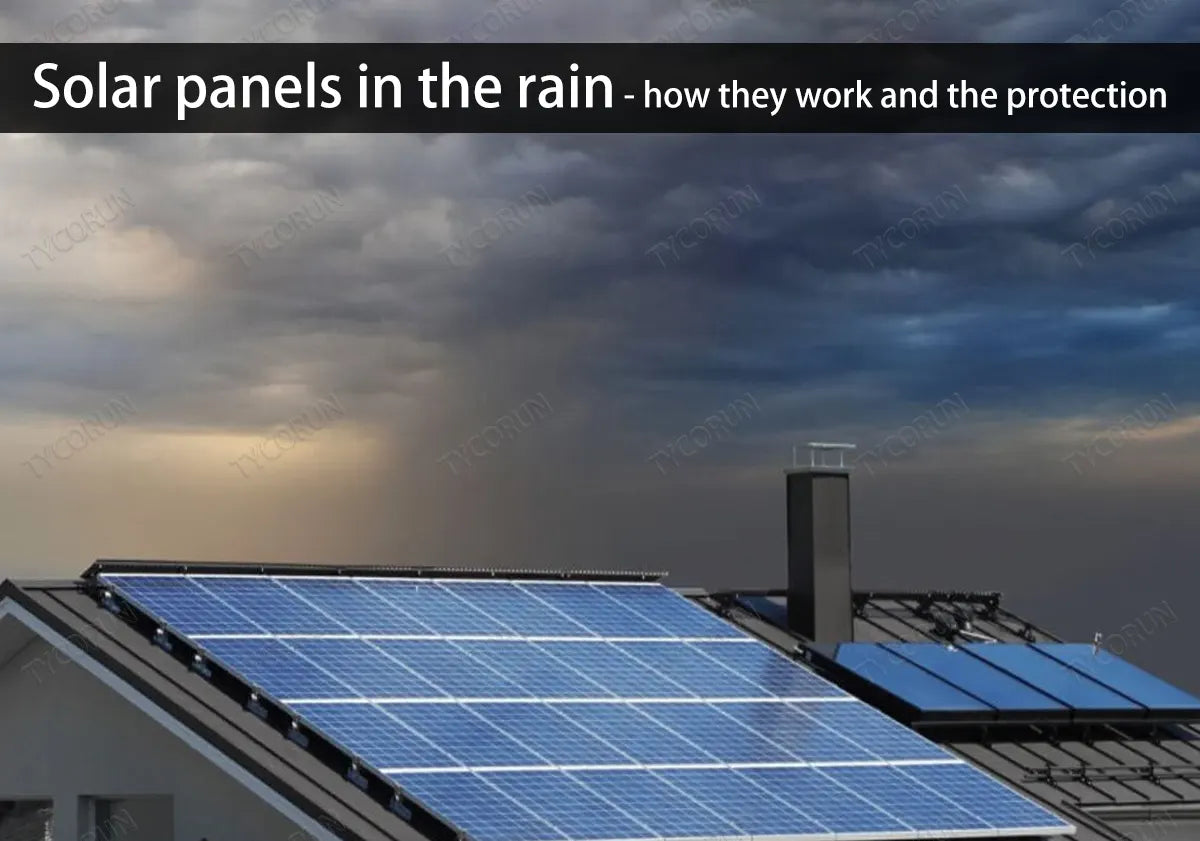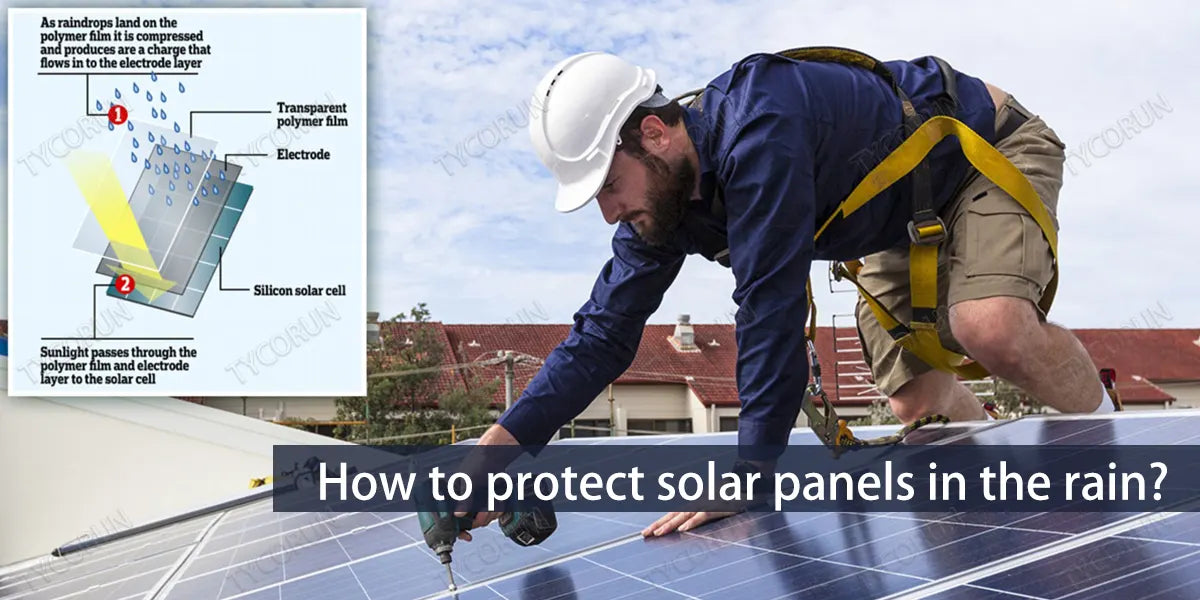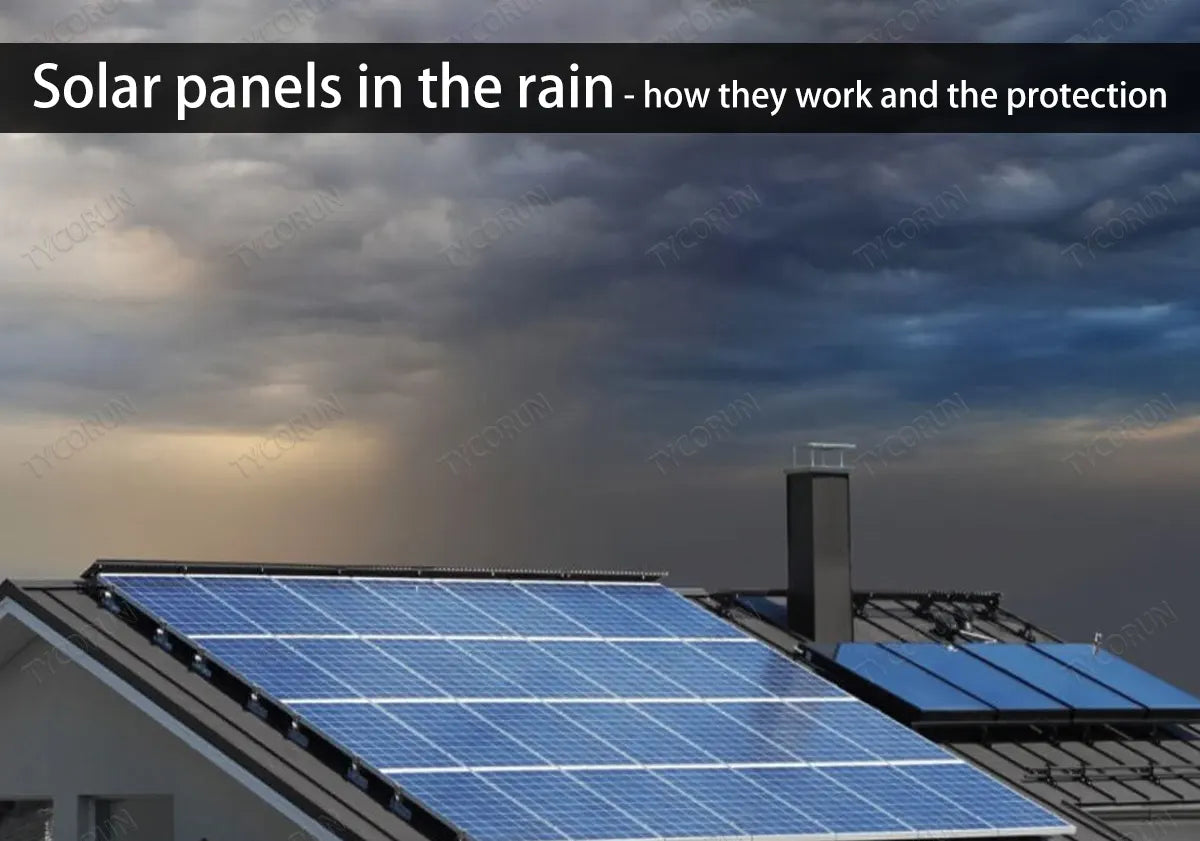
We all know that solar panels generate electricity by absorbing sunlight, so can they still work on rainy days? This article will answer this question for you and provide some methods and suggestions for protecting solar panels in the rain.
Main content:
1. Do solar panels work on rainy days?
We all know that the power generation of photovoltaic power stations is directly related to solar radiation. In rainy weather, the power generation of photovoltaic power stations will be very low. So, does the photovoltaic power station generate no electricity at all when it rains?
No, in fact, the current photovoltaic modules can also generate electricity to a certain extent under conditions of low light. This is also the reason why photovoltaic power stations can still generate electricity in rainy weather.
In fact, as long as there is light, light particles can collide with solar panels to generate electricity. On rainy days, even if the sun is not visible, the panels can still generate electricity. According to Planck's law, the energy of an incident photon is inversely proportional to its wavelength. Short-wavelength radiation occupies the violet end of the spectrum and includes ultraviolet radiation and gamma rays.

On the other hand, long wavelength radiation occupies the red end and includes infrared radiation, microwaves, and radio waves. Therefore, solar panels in the rain can still generate electricity, but due to current technical reasons, the efficiency of solar energy conversion of solar panels in the rain is still very low.
At present, it is also possible to generate electricity through friction on rainy days. On rainy days, it will be converted into graphene to generate electricity. Because there are ions such as sodium, calcium, and ammonium in rainwater, the positively charged ion layer will interact with the negatively charged electrons of graphene, resulting in a double-layer structure similar to a pseudocapacitor. The potential difference between these two layers is large enough to generate voltage and current.
There are many factors that affect solar power generation, such as the thickness of solar panels. Photons can shuttle between solar panels and hit other particles, resulting in the loss of energy. Another factor that affects efficiency is the reflectivity of the solar batteries. To reduce the loss of reflectivity and increase efficiency, solar battery manufacturers often coat the cells with non-reflective, light-absorbing materials. This is the reason why are solar panels black.
And we have also introduced how to deal with solar panels in snow, for further information, you can click to check solar panel snow removal.

2. How to ensure the power generation of solar panels in the rain
As mentioned above, solar panels in the rain can still work, but many people still have some concerns about whether the photovoltaic power station will cut off power due to insufficient power on rainy days.
In fact, in rainy weather or haze weather, when solar radiation is low, if the operating voltage of the photovoltaic power generation system cannot reach the starting voltage of the inverter, the photovoltaic power generation system will not work. Since the on-grid power generation system is connected to the grid, when the photovoltaic power generation system cannot operate, the electricity from the grid will be automatically replenished, so there will be no problems of power shortage or power outage in the rain or haze.
More and more people are now installing home solar power system on their roofs. For this kind of household power station, how can we ensure stable power generation and not be affected by the weather? Refer to the following three methods to ensure power generation!
① Preliminary design of the power system
When designing a household power station, you need to choose a suitable location. For example, if the solar panels are built on the roof, the fixed load of the roof, wind pressure load, snow pressure load, and earthquake load must be taken into consideration. Generally, the "Building Structural Load Code" will be followed, because only this can prevent the power station from being damaged due to rainy weather.

② Complete photovoltaic bracket matrix installation
The bracket matrix plays a role in supporting the solar panels in the entire photovoltaic power station. At the same time, the design direction of the bracket matrix is closely related to the power generation of the solar panels in the rain.
First of all, the installation cannot be done casually. The orientation of the power station installation process should face south, so that it can fully receive the sun's illumination. The solar panel angle is theoretically equal to or close to the local latitude, and the arrangement and spacing need to be determined based on the local sunshine and roof structure dimensions.
③ Choose qualified equipment
The equipment mentioned here includes components, inverters (like 2000w inverter or 3000w inverter), and brackets. Mainstream inverter manufacturers basically adopt IP65 protection level and have waterproof performance, but long-term rainy weather still has a great impact on the equipment.
If the photovoltaic product you choose cannot withstand long-term rain, the power generation capacity will not increase, no mention the profits. When the photovoltaic brackets have been immersed in water for long term, how can they not rust for 10 years, keep their rigidity for 20 years, and stay certain structural stability for 25 years? All of these require special requirements on the material of the brackets.
3. How to protect solar panels in the rain?
When the rainy season comes, rainfall will be more frequent and stronger, and some areas will face extreme weather attacks such as typhoons. In bad weather, it is necessary to protect the photovoltaic power system and deal with damaged equipment in a timely manner to avoid causing more serious property losses and affecting personal safety.
① Inspection
First of all, according to the weather warning information issued by the local meteorological station, inspections of photovoltaic power stations should be carried out in advance. Conduct a comprehensive and detailed inspection of the installation and equipment operation of the photovoltaic power station, including checking whether the screws and fasteners are tight and secure, checking whether the medium voltage block and side pressure block of the photovoltaic power station are loose, and tightening them in time.
For photovoltaic power stations installed with hooks and clamps, you should check whether the corresponding equipment is secure. In addition, it is also necessary to check the insulation sealing of each electrical equipment. If the photovoltaic power station is located on low ground, the on-grid inverter should be removed from the site in time or re-placed on high ground.
② Windproof preparation
Secondly, strengthen the wind prevention preparation work for solar panels in the rain. If the photovoltaic power station is installed on a flat roof, iron wires can be used to bind and fix the series modules on the windward side.
For power stations with smaller fixed piers, sandbags can be used to increase the counterweight of the power station. For photovoltaic power stations without protective brackets, install and tighten windproof tie rods to prevent the photovoltaic brackets from twisting in the wind; ground power stations should compact the ground anchors on both sides of the array.

③ Drainage
When heavy rain comes, it is often accompanied by thunderstorms or strong winds. If the drainage system in some areas cannot handle it, floods may occur. For household photovoltaic power stations, the drainage capacity of the roof is strong, and generally there will be no water wading. What needs to be alerted is that the position of the fixed components will be soaked by the rising water level, causing failure. Cut off the grid-connected switch at home in time before the water level rises to ensure the safety of the equipment to the greatest extent.
④ Inspection after rain
When checking the photovoltaic power station after rain, you should pay attention to:
- Check the electrical box, and pay special attention to whether there is any problem with the surge protector;
- Check whether the solar panels are damaged, and clean up the debris on the solar panel promptly. If cracked components are found, replace as soon as possible.
- Avoid touching sockets, switches, distribution boxes and other live equipment with bare hands to avoid increasing the risk of electric shock.
- There may be a circuit short circuit in the equipment after wading into the water. Professional operation and maintenance personnel should be contacted as soon as possible for inspection and treatment. At the same time, the losses can be recovered as much as possible through insurance claims.
⑤ Protection warning
If multiple connected solar panels in the rain are blown away by wind or washed away by water, if they are powered on, they may generate electricity under sunlight and generate high voltage and current. It is necessary to pull up protection ropes around it to prevent other people from accidentally entering.
⑥ Measures to deal with landslides
Heavy rains may cause the soil moisture content around the solar power station to become saturated. Coupled with the lack of vegetation protection, large-scale landslides may occur, seriously endangering the safety of the power station. If a landslide occurs, first of all, timely rescue operations should be carried out to save lives.
Emergency measures must also be taken in the landslide area, such as laying plastic sheets and emergency closing of the power gates in the power station to protect the power station equipment. As for the subsequent processing of the photovoltaic power station or if it is seriously damaged and needs to be scrapped, you should contact the operation and maintenance personnel before proceeding.
Related posts: difference between on grid and off grid inverter, global top 10 best solar inverter brands, top 10 best inverter brands in India















